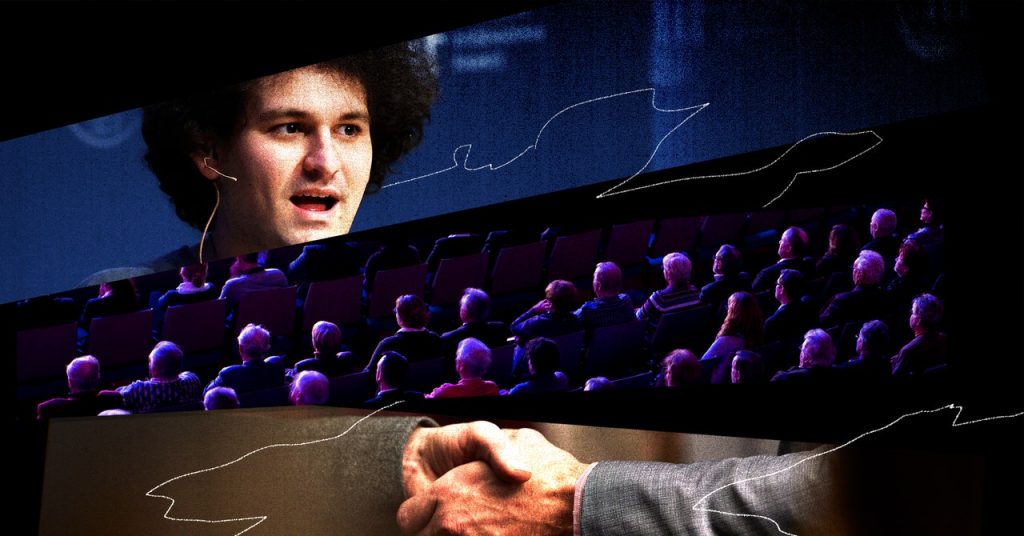Aditiya Baradwaj joined crypto-trading firm Alameda Research when it was run out of an anonymous first-floor office in downtown Berkeley, California. It was September 2021, and the day Baradwaj arrived, Sam Bankman-Fried, the company’s founder, was sitting in the middle of the trading floor playing League of Legends. By then, Bankman-Fried was already more than a crypto billionaire. Alameda was a whale in crypto markets; FTX, the exchange Bankman-Fried had started in 2019, had more than a million customers. FTX’s latest funding round, in July 2021, had raised nearly $1 billion from A-list investors that included Sequoia and SoftBank.
Bankman-Fried was an unlikely poster boy for the industry: mop-haired, academic, exuding on screen a kind of nerdy anti-charisma that set him apart from the brashness of the crypto world. He was also, famously, a proponent of effective altruism—a philosophy that espouses making money to give it away. He wasn’t just a crypto booster; he was making billions of dollars to save the world, and Baradwaj found that compelling. “It’s kind of a noble mission,” Baradwaj says. “And it’s contrary to the mission of a lot of trading firms … where, you know, the goal is just like, ‘make money.’”
Within months, Baradwaj was on FTX’s rocket ship. Alameda’s headquarters was in Hong Kong; Bankman-Fried and FTX were in the process of moving their operation to the Bahamian capital, Nassau. Staff moved freely between the two. There were parties and conferences with celebrities and political leaders that helped cement the companies’ status. “Sam’s face was on the cover of Forbes. And, you know, everyone was calling him a genius,” Baradwaj says. “It made it very easy to believe that we were part of something really unique and special, and that it was going to keep going, and it was never going to end.”
But according to a complaint by the US Department of Justice, by the time Baradwaj joined Alameda, the company was already using customers’ deposits to fund its own trading—behavior that, as crypto markets tanked in 2022, would ultimately lead to FTX’s bankruptcy, to hundreds of thousands of customers losing their investments, and to criminal charges against Bankman-Fried, Alameda CEO Caroline Ellison, and other senior figures at both companies. Behind the collapse of the exchange is, allegedly, one of the largest financial frauds in history, one in which Bankman-Fried and his inner circle deceived not only ordinary punters, but venture capitalists, institutional investors, and sovereign wealth funds—and people who worked for them. Several Alameda and FTX executives have already pleaded guilty to various charges of fraud and conspiracy. Bankman-Fried goes on trial in New York tomorrow. The trial is likely to focus on whether he, and others, consciously deceived their investors. What it won’t answer is why those investors were so easy to fool.
“It’s natural to ask the question, how could Sam and Caroline and the others have deceived so many people, including people who are closest to them?” Baradwaj says. “I mean, think about the investors that invested in FTX, with access to all the documents they could ever want about the company’s financials, and they still poured hundreds of millions of dollars into this enterprise. I think that tells you something about the reality distortion field that a lot of these figures can have around them.”
Silicon Valley could be said to be in the business of reality distortion. Fundraising for startups can be as much about narrative as about economic fundamentals. Most venture capital portfolios are filled with companies that will fail because their model is wrong, their product won’t land, their vision of the future won’t pan out. The high dropout rate means that everyone is in search of the one thing that will reach escape velocity. Everyone is looking for an epochal success—a Steve Jobs, a Jeff Bezos. That creates a degree of hunger—even desperation—that can be exploited by someone who arrives with a great story at the right moment.
Read the full article here









